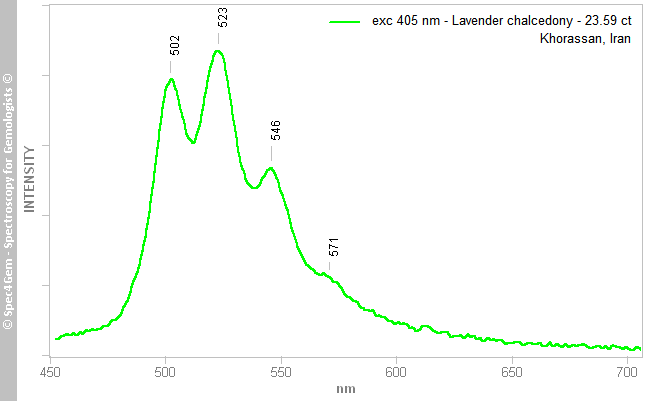Lavender chalcedony from Khorassan, Iran
- Details
- Created: Wednesday, 30 November 2016 21:10
Yet another kind of material coming from the former province of Khorassan in Iran as the gem-silica type described in 'greenish-blue chalcedony, a "gem silica" from Khorassan, Iran'. This is a material with a quite even lavender color as shown in figure 1. It may contain some tiny black inclusions as well as larger brown ones.
In 2003, a similar material[1] was discovered in the Qom area near the Qom Salt Lake, about 150 km southwest of Teheran. The material was grayish-violet and displayed a weak adularecence.
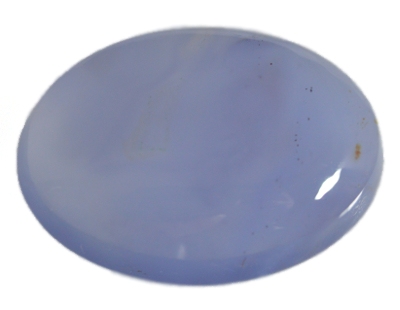 Figure 1. 23.59 ct lavender chalcedony from Khorassan, Iran
Figure 1. 23.59 ct lavender chalcedony from Khorassan, Iran| Shape | oval cab |
| Size | 24.3 x 17.6 x 7.2 mm |
| Color | lavender (light bluish-violet) in reflected light / very light lavender to almost colorless in transmitted light |
| Lustre | vitreous, translucent |
| Weight | 23.59 ct |
| SG | 2.60 |
| RI | - |
| DR | - |
| Pleochroism | - |
| Polariscope / Conoscope | remains light through a full rotation -> polycristalline |
| SWUV | inert |
| LWUV | inert |
| Magnetic susceptibility | slightly diamagnetic |
Table 1. Observational and measured properties
Infrared reflectance spectroscopy:
The IR reflectance spectrum (figure 2) was acquired from the top of the lavender 23.59 ct chalcedony cab. It shows the spectrum pattern of chalcedony with the 'rounded' 692, 780 and 799 bands (not as sharp as for crystalline quartz), confirming the cab as being chalcedony.
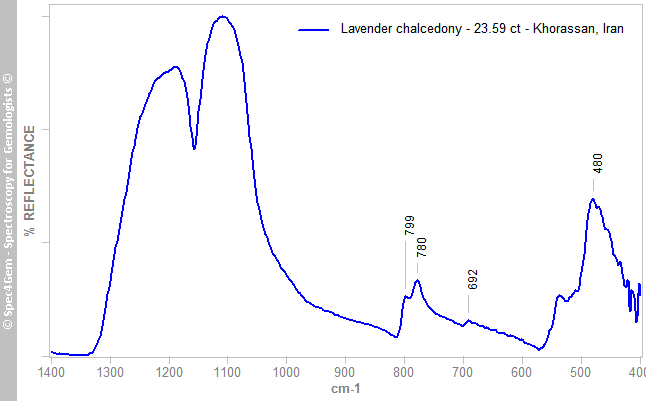 Figure 2. The IR reflectance spectrum, acquired from the top of the lavender 23.59 ct chalcedony cab from Khorassan in Iran, shows a spectrum pattern with 'rounded' 692, 780 and 799 bands (not as sharp as for crystalline quartz) confirming it is chalcedony.
Figure 2. The IR reflectance spectrum, acquired from the top of the lavender 23.59 ct chalcedony cab from Khorassan in Iran, shows a spectrum pattern with 'rounded' 692, 780 and 799 bands (not as sharp as for crystalline quartz) confirming it is chalcedony.UV-VIS-NIR spectroscopy:
The UV-Vis-NIR absorption spectrum (figure 3) was acquired with a light path parallel to the normal to the cab's top. It consists in a transmission window in the violet-blue around 440 nm, created by to surrounding absorptions, one in the UV-violet and the other in the yellow around 595 nm. The created transmission window explains the observed color which is not violet like amethyst but an unsaturated violet, slightly bluish (lavender color).
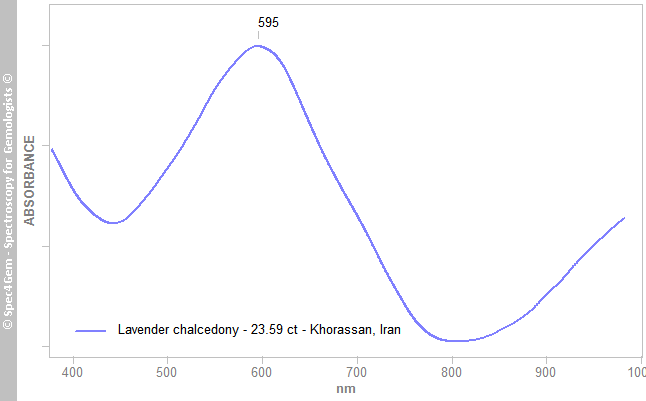 Figure 3. UV-Vis absorption spectrum of the 23.59 ct cab showing a main absorption at 595 nm and an absorption edge extending to UV.
Figure 3. UV-Vis absorption spectrum of the 23.59 ct cab showing a main absorption at 595 nm and an absorption edge extending to UV.In amethyst (the violet quartz variety), the UV-Vis-NIR absorption spectrum presents a similar spectrum pattern with the exception the pattern is shifted to higher energies. The transmission window and the main absorption are respectively and approximately at 450 and 520 nm for amethyst whereas they are at 440 and 595 nm in this chalcedony. The broadened transmission window probably explains the lack of saturation (colorfulness) of the violet and the blue hue which is present.
Color in amethyst[2][3][4][5] is due to Fe4+ iron impurities that formed by natural irradiation of Fe3+. Discrepancies between amethyst and this chalcedony UV-Vis spectra do not find any satisfying explanation. Could this material be colored by exogenous colored inclusions? Microscope observation up to 80x did not revealed any colored inclusions.
However the visual observation of the cab gave some hints because the cab looked more bluish while observed in reflection / transmission orthogonally to incident light. This phenomenon is usually observed in some opals and chalcedonies. It is explained by light scattering caused by small particles composing the material, either as the intrinsic material in the opal case or as impurities in the chalcedony case[5]. From that observation, some extra absorption (thus transmission) spectra were acquired but proceeding with a light collection operated as follows:
- with direct light transmission (collection device captures the light in the light source direction), identified as 180°,
- with orthogonal light transmission (collection device captures the light orthogonally to the light source beam direction), identified as 90°.
The UV-Vis-NIR transmission spectra collected at 180° (red spectrum) and 90° (blue spectrum) to the light source beam direction are displayed in figure 4. One can easily observe that the violet, blue and geen colors are more transmitted in the 90° direction than in the 180° one, while this is the opposite for the yellow, orange and red colors. The difference between the spectra is plotted with the light colors, showing what colors are more transmitted and what colors are less transmitted.
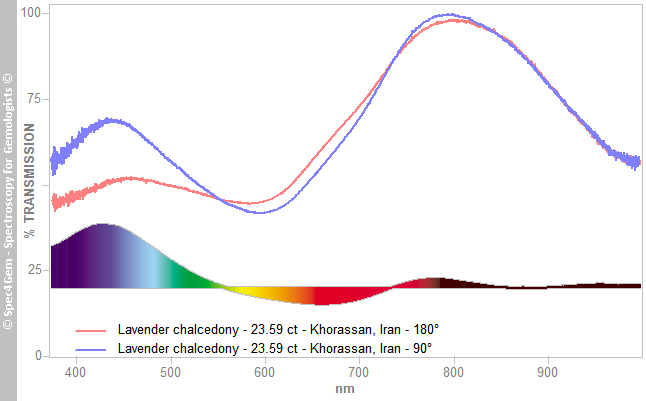 Figure 4. UV-Vis-NIR transmission spectra collected at 180° (red spectrum) and 90° (blue spectrum) to the light source beam direction. One can easily observe that the violet, blue and geen colors are more transmitted in the 90° direction than in the 180° one, while this is the opposite for the yellow, orange and red colors. The difference between the spectra is plotted with the light colors, showing what colors are more transmitted and what colors are less transmitted.
Figure 4. UV-Vis-NIR transmission spectra collected at 180° (red spectrum) and 90° (blue spectrum) to the light source beam direction. One can easily observe that the violet, blue and geen colors are more transmitted in the 90° direction than in the 180° one, while this is the opposite for the yellow, orange and red colors. The difference between the spectra is plotted with the light colors, showing what colors are more transmitted and what colors are less transmitted.The differential transmission of light as per the direction from which the incident light is observed is likely the result of light scattering. The scattering phenomenon should not be confused with the pleochroism of anisotropic materials. Anyhow it is impossible to conclude from the UV-Vis-NIR spectroscopy that the light scattering, likely Mie scattering, is the only cause of color explaining the color of this particular chalcedony.
Photoluminescence spectroscopy:
The chalcedony cab luminescence was excited by a 405 nm laser, the photoluminescence spectrum (figure 5) shows the characteristic green luminescence of UO22+ uranyl ion. The presence of uranyl ion in chalcedony is not exceptional, it does exists in many chalcedonies from around the world.
The peaks position are k0=502 (~ 19925 cm-1), k1=523 nm (~19120 cm-1, Δk0=805 cm-1), k2=546 nm(18315 cm-1, Δk1=805 cm-1), k3=571 nm (~17513 cm-1, Δk2=802 cm-1). Calculating the k and Δk would required a high resolution spectrometer as well as a meticulous determination of the emission peaks positions (i.e. at 502 nm, a variation of 1 nm is equivalent to 35 cm-1). Working at Nitrogen temperature would also increase the sharpness of the peaks. Anyway, we approximately have k0 ~19925 cm-1 and Δk ~805 cm-1. These results are very similar to that of Gorobets and Rogojine[7]: k0=20090±50 cm-1 and Δk=820±5 cm-1. These uranyl ions result of the absorption of the UO22+.nH2O aqua-complexes by the chalcedony.
Conclusion:
This lavender cab is a new material coming from the former Khorassan province in Iran. The material is quartz chalcedony with common gemological properties for such gemstone. The lavender color is likely caused by light scattering but it is not sure if it is the only color cause, any other color cause cannot be excluded yet. This chalcedony material hosts UO22+ ions that are easily detected because of their green luminescence.
[1]&nbps;Adularescent chalcedony from Iran. Gems & Gemmology, 2004, Winter, p. 337.
[2] Caltech - Quartz Varieties Visible Spectra (generally 350 - 1100 nm).
[3] Biaxial Color Centers in Amethyst Quartz, F. Hassan, Alvin J. Cohen, American Mineralogist, Volume 59 pp. 709-718, 1974.
[4] Spectroscopic study of natural quartz samples, Eduardo H.M. Nunes, Fernando S. Lameiras, Manuel Houmard, Wander L. Vasconcelos, Radiation Physics and Chemistry 90 pp. 79-86, 2013.
[5] Review of some current coloured quartz varieties, Ulrich Henn and Rainer Schultz-Güttler, Journal of Gemmology, 2012, volume 33, No.1-4, pp. 29–43.
[6] Rock-forming Minerals: Silica Minerals, Volume 4B, William Alexander Deer, Robert Andrew Howie, 1978, 2nd edition, p 99.
[7] Luminescent Spectra of Minerals, Boris S. Gorobets and Alexandre A. Rogojine, Moscow, 2002, ISBN: 5901837053, pp. 263-266.


